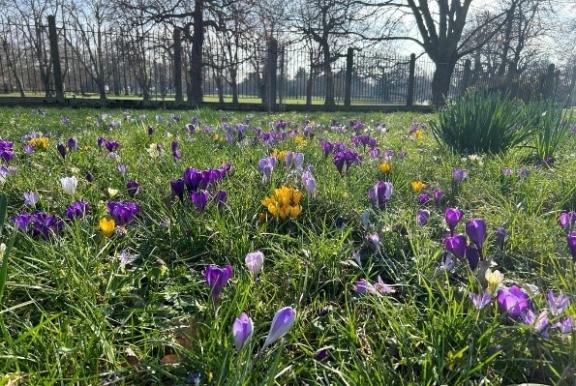The Antwerp Arms – ‘The Annie’
At springtime in this historic corner of Tottenham, the award-winning and delightful community pub affectionately known as The Annie is framed beautifully by the colony of purple, white and yellow crocuses. Looking across the park to Bruce Castle, The Antwerp Arms has been a popular local watering hole for at least 170 years, but how did it acquire its name?

Previous thoughts believed this old pub might have already reached its 200th anniversary. But maps and other documents could only show that the pub was around from 1850, known as the Hope and Anchor with William Saunders as beer retailer. By 1861, there had been a name change - to the Antwerp Arms, with Charles Mason as beer maker and beer seller.
Local myths have emerged as to why it was called The Antwerp. One story most know – and can now be dismissed – is that in 1894, the brewers, Charringtons, were highly-commended in a brewery exhibition in Antwerp in the Netherlands. It is said the brewery named the pub in celebration. There was certainly ‘The Exposition International d’Anvers’, part of the ‘World’s Fair’ which took place in Antwerp in 1894. Although the brewery may well have won a prize there and had cause for celebration that year, they may have been just happy to already have a pub that they ran with this name (since 1861). You can read more here about some of the characters who frequented The Annie during the mid-1950s, as observed by local Jim Clark who loved going to the pub in this rural setting.

(The Antwerp Arms in Church Road, in the late 1970s. From the collections of and © Bruce Castle Museum and Archive)
Further resources
Bruce Castle Park - A brief history
16th century
There has been a manor house for Tottenham on this site for about 1,000 years with the present Bruce Castle dating from the 1500s. For centuries the grounds supported the household at the manor house with a kitchen garden, orchards, pasture for livestock, and ancient medieval stew ponds for cleaning fish caught in the nearby River Lea. The north edge of the park today is a noticeably higher level to the road. This is what remains of a ‘ha-ha’ - a ditch to keep livestock in and deer out.
18th century
The north edge became higher still, with the top known as Mount Walk. The grounds were fashionably landscaped with pleasure gardens for the residents of Bruce Castle, popular for outdoor entertainment for their visitors.
Rent-a-Pineapple?
A product of European colonialism, in the 18th century pineapples became symbolic of wealth, luxury and prestige for the ruling classes. In the mid-1700s, Bruce Castle was owned by Henrietta and her husband James Townsend MP who were determined to stay up-to-date on the latest trends, no matter the cost. The old kitchen garden ran alongside the 17th century south boundary wall (Grade II listed) on Lordship Lane.
In the area nearest to what is now the Holocaust Memorial garden, the Townsends had a ‘pinery’, a special garden-house where pineapples could be grown for the household of Bruce Castle. This was an unusual feature in the gardens of any well-to-do households. Pineapples were of course a rarity in this country and difficult to grow. Once it became a must-have fashionable feature for dinner parties of the rich, it was often the case that a pineapple was rented for the dinner table – it wasn’t for eating! It was simply a decorative piece to show off, as a symbol of class wealth. For the Townsends, they could have their own pineapples!
The rise, fall, and rise of the status pineapple.
19th century
By 1827 Bruce Castle was a school run by the Hill family. Outhouses were added in the grounds, used for scientific experiments and ventures. The school had its own cow-keeper to keep livestock and a much-loved donkey in the grounds. Schoolboys played sports here, including real tennis, fencing and cricket. Locals could come into the school grounds and watch cricket matches.

(Victorian visitors to Bruce Castle School, c.1870. From the collections of and © Bruce Castle Museum and Archive)
A little grotto, located where the Memorial Garden is today, was where the schoolboys could relax.
Bruce Castle School closed in 1891, and thanks to the advocacy of local philanthropist Joshua Pedley, in 1892 its grounds became Tottenham’s first public park.

(Waiting at the bandstand in Bruce Castle Park, 1890s. From the collections of and © Bruce Castle Museum and Archive)
The Ancient Oak
Majestic mature trees and individual specimens, including a gingko bilobo tree and mulberry tree, make the park an ecological haven hosting incredible wildlife and habitats. The park is also home to a stately and much-admired ancient oak tree, believed to be about 500 years old. Counted as one of the Great Trees of London, the Great Bruce Castle Oak was voted runner up in the Woodland Trust’s Tree of the Year award in 2018. You can read more about the Bruce Castle Oak at the information board by the tree, written by the Friends of Bruce Castle Park.
To see more of the history of Bruce Castle and the park today, visit the Museum to explore the stories, artefacts, paintings, photographs and maps from over the centuries. There are also Tree Trails for families available in the shop at Bruce Castle Museum.

(Branches of the Great Bruce Castle oak. From the collections of and © Bruce Castle Museum and Archive)
Further resources
Bruce Castle Oak: Special tree of Tottenham - Tottenham Trees
Location
Pints and Promenades
168-170 Church Rd,
Tottenham
N17 8AS
United Kingdom